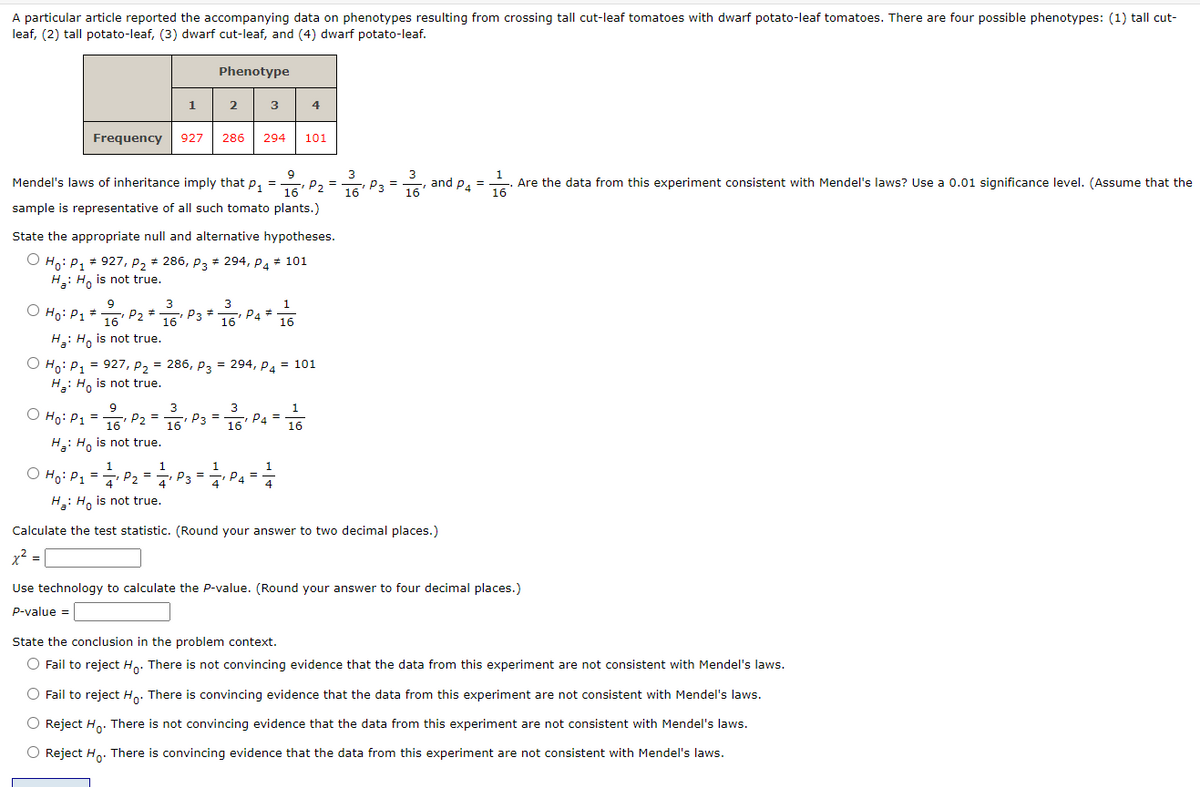A particular article reported the accompanying data on phenotypes resulting from crossing tall cut-leaf tomatoes with dwarf potato-leaf tomatoes. There are four possible phenotypes: (1) tall cut- leaf, (2) tall potato-leaf, (3) dwarf cut-leaf, and (4) dwarf potato-leaf. O Ho: P1 = 9 1 Frequency 927 286 294 101 9 Mendel's laws of inheritance imply that p₁ P₂ sample is representative of all such tomato plants.) 16 H: Ho is not true. Phenotype State the appropriate null and alternative hypotheses. O Ho: P₁ # 927, P₂ * 286, P3 # 294, P4 # 101 H: Ho is not true. 2 3 -P₂ * 1/6₁P3 *- P4 # 1/1/160 O Ho: P₁ = P₂ 3 H: Ho is not true. Ho: P₁ = 927, P₂ = 286, P3 = 294, P4 = 101 H: H is not true. O Ho: P₁ = -1 P₂ = 1/61P3 = 161 P4 = H: Ho is not true. P3 4 P4= = 1/1600 11/0₁P3 = 23/01/²0 and P4 = Calculate the test statistic. (Round your answer to two decimal places.) x² = . Are the data from this experiment consistent with Mendel's laws? Use a 0.01 significance level. (Assume that the Use technology to calculate the P-value. (Round your answer to four decimal places.) P-value = State the conclusion in the problem context. O Fail to reject Ho. There is not convincing evidence that the data from this experiment are not consistent with Mendel's laws. O Fail to reject Ho. There is convincing evidence that the data from this experiment are not consistent with Mendel's laws. O Reject Ho. There is not convincing evidence that the data from this experiment are not consistent with Mendel's laws.
A particular article reported the accompanying data on phenotypes resulting from crossing tall cut-leaf tomatoes with dwarf potato-leaf tomatoes. There are four possible phenotypes: (1) tall cut- leaf, (2) tall potato-leaf, (3) dwarf cut-leaf, and (4) dwarf potato-leaf. O Ho: P1 = 9 1 Frequency 927 286 294 101 9 Mendel's laws of inheritance imply that p₁ P₂ sample is representative of all such tomato plants.) 16 H: Ho is not true. Phenotype State the appropriate null and alternative hypotheses. O Ho: P₁ # 927, P₂ * 286, P3 # 294, P4 # 101 H: Ho is not true. 2 3 -P₂ * 1/6₁P3 *- P4 # 1/1/160 O Ho: P₁ = P₂ 3 H: Ho is not true. Ho: P₁ = 927, P₂ = 286, P3 = 294, P4 = 101 H: H is not true. O Ho: P₁ = -1 P₂ = 1/61P3 = 161 P4 = H: Ho is not true. P3 4 P4= = 1/1600 11/0₁P3 = 23/01/²0 and P4 = Calculate the test statistic. (Round your answer to two decimal places.) x² = . Are the data from this experiment consistent with Mendel's laws? Use a 0.01 significance level. (Assume that the Use technology to calculate the P-value. (Round your answer to four decimal places.) P-value = State the conclusion in the problem context. O Fail to reject Ho. There is not convincing evidence that the data from this experiment are not consistent with Mendel's laws. O Fail to reject Ho. There is convincing evidence that the data from this experiment are not consistent with Mendel's laws. O Reject Ho. There is not convincing evidence that the data from this experiment are not consistent with Mendel's laws.
Algebra & Trigonometry with Analytic Geometry
13th Edition
ISBN:9781133382119
Author:Swokowski
Publisher:Swokowski
Chapter10: Sequences, Series, And Probability
Section10.8: Probability
Problem 32E
Related questions
Question

Transcribed Image Text:A particular article reported the accompanying data on phenotypes resulting from crossing tall cut-leaf tomatoes with dwarf potato-leaf tomatoes. There are four possible phenotypes: (1) tall cut-
leaf, (2) tall potato-leaf, (3) dwarf cut-leaf, and (4) dwarf potato-leaf.
1
Phenotype
2
Frequency 927 286 294
9
3
3
1
Mendel's laws of inheritance imply that P₁ = P₂ = 16P3 = 16 and P4 = -
-₁
16
3
3
O Ho: P1 * → P₂ == - P3 -
9
16
16
16
H: Ho is not true.
9
3
O
| Ho: P₁ = 1/6¹ P2 = 16¹ P3:
H: Ho is not true.
3
16
sample is representative of all such tomato plants.)
1
1
O Ho: P₁ = = ₁ P₂ = = ₁ P3=
4
H₂: Ho is not true.
State the appropriate null and alternative hypotheses.
#
O Ho: P₁ # 927, P₂ ‡ 286, P3 # 294, P4 # 101
H:Ho is not true.
"I
P4 #
1P3 = 2/1/1₁ P4
O Ho: P₁ = 927, P₂ = 286, P3 = 294, P4 = 101
P1
H₂: Ho is not true.
0
3
=- P4=
16
4
1
16
101
---
4
1
16
Calculate the test statistic. (Round your answer to two decimal places.)
x² = 1
Are the data from this experiment consistent with Mendel's laws? Use a 0.01 significance level. (Assume that the
Use technology to calculate the P-value. (Round your answer to four decimal places.)
P-value =
State the conclusion in the problem context.
O Fail to reject Ho. There is not convincing evidence that the data from this experiment are not consistent with Mendel's laws.
O Fail to reject Ho. There is convincing evidence that the data from this experiment are not consistent with Mendel's laws.
O Reject Ho. There is not convincing evidence that the data from this experiment are not consistent with Mendel's laws.
O Reject Ho. There is convincing evidence that the data from this experiment are not consistent with Mendel's laws.
Expert Solution
This question has been solved!
Explore an expertly crafted, step-by-step solution for a thorough understanding of key concepts.
This is a popular solution!
Trending now
This is a popular solution!
Step by step
Solved in 2 steps with 1 images

Recommended textbooks for you

Algebra & Trigonometry with Analytic Geometry
Algebra
ISBN:
9781133382119
Author:
Swokowski
Publisher:
Cengage

Algebra & Trigonometry with Analytic Geometry
Algebra
ISBN:
9781133382119
Author:
Swokowski
Publisher:
Cengage